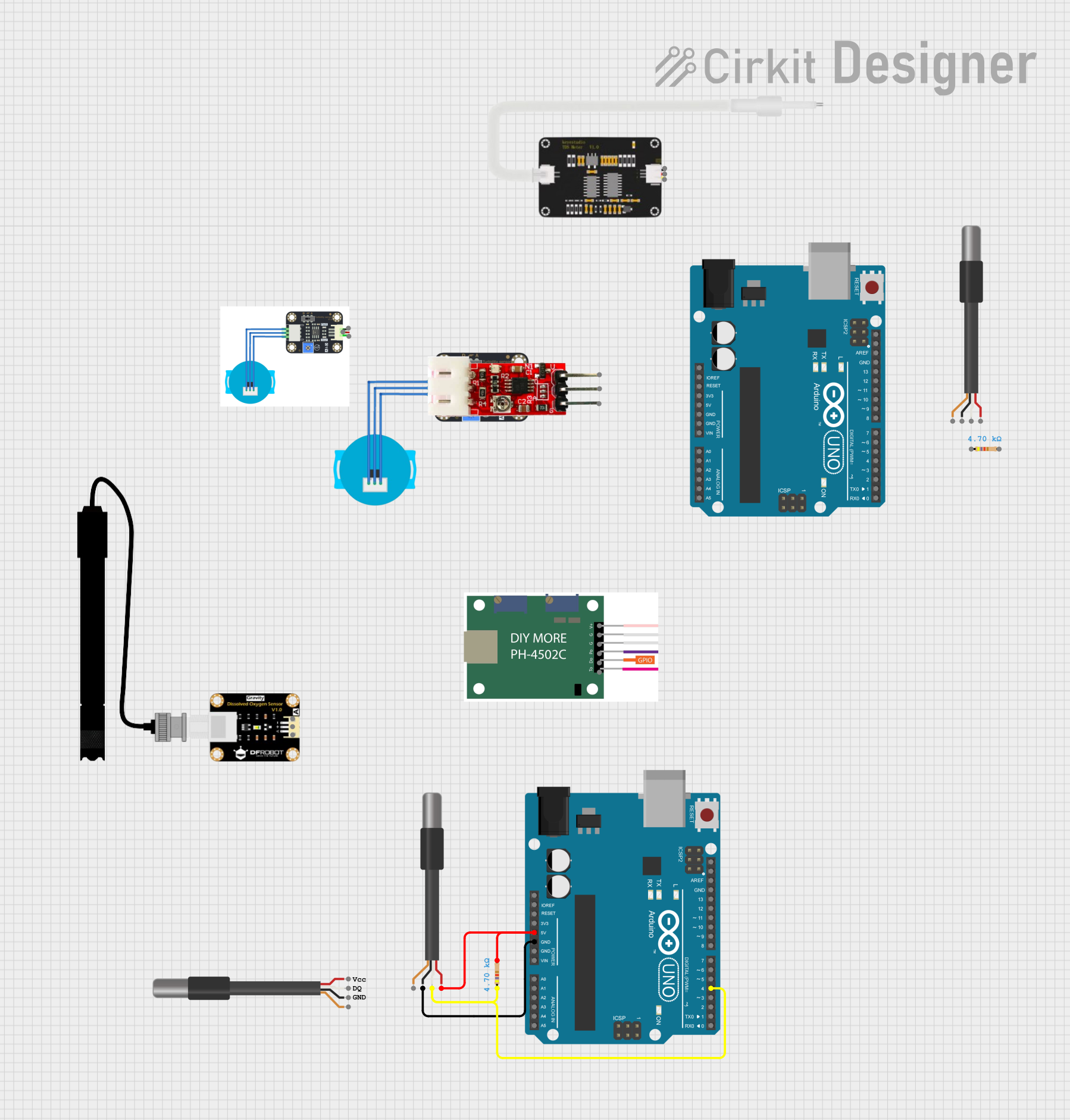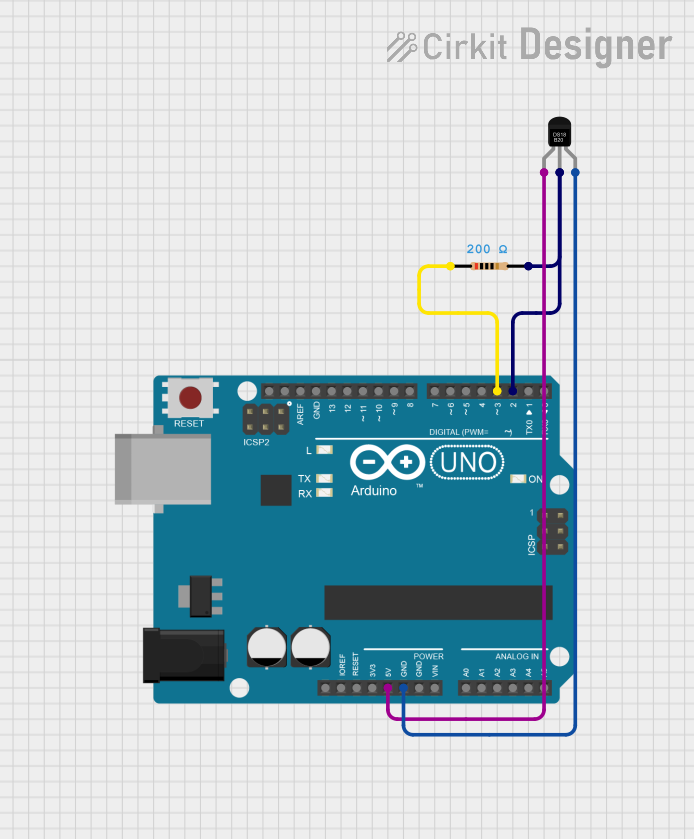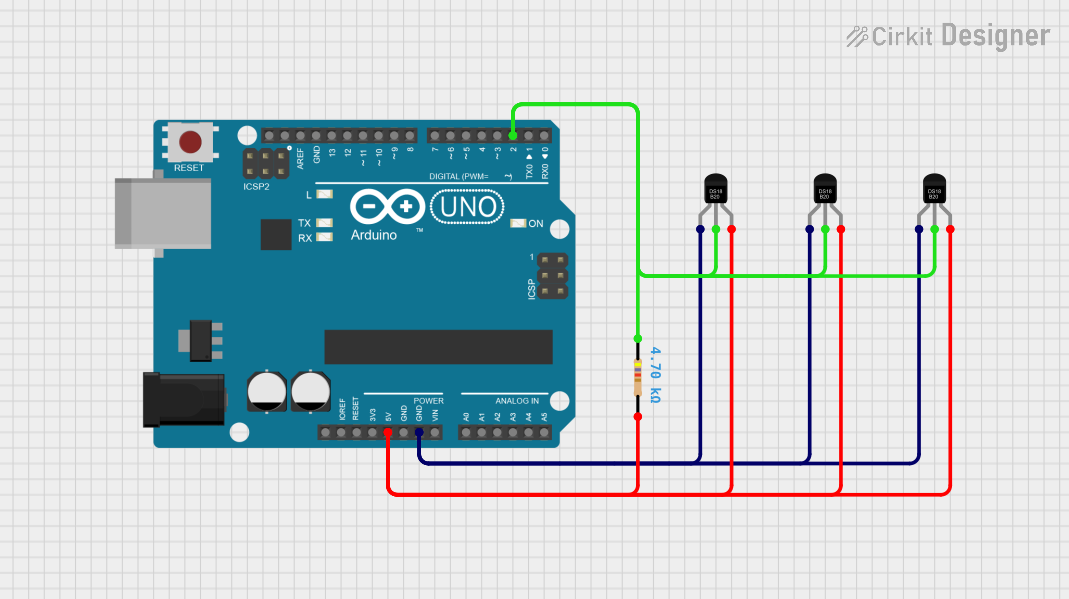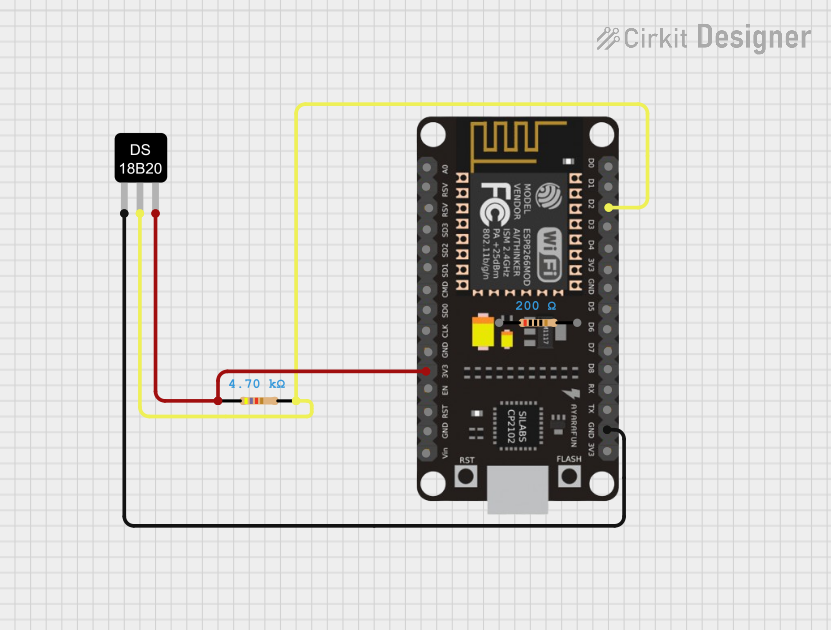
How to Use DS18B20 Digital Temperature Sensor: Examples, Pinouts, and Specs

 Design with DS18B20 Digital Temperature Sensor in Cirkit Designer
Design with DS18B20 Digital Temperature Sensor in Cirkit DesignerIntroduction
The DS18B20 is a digital temperature sensor manufactured by DF Robot, with the part ID "Temperature Sensor." It is designed to provide accurate temperature readings in the range of -55°C to +125°C. The sensor communicates using a 1-Wire interface, which allows multiple sensors to be connected to a single data line. This makes it an excellent choice for applications requiring temperature monitoring in environments such as industrial systems, weather stations, and home automation.
Explore Projects Built with DS18B20 Digital Temperature Sensor

 Open Project in Cirkit Designer
Open Project in Cirkit Designer
 Open Project in Cirkit Designer
Open Project in Cirkit Designer
 Open Project in Cirkit Designer
Open Project in Cirkit Designer
 Open Project in Cirkit Designer
Open Project in Cirkit DesignerExplore Projects Built with DS18B20 Digital Temperature Sensor

 Open Project in Cirkit Designer
Open Project in Cirkit Designer
 Open Project in Cirkit Designer
Open Project in Cirkit Designer
 Open Project in Cirkit Designer
Open Project in Cirkit Designer
 Open Project in Cirkit Designer
Open Project in Cirkit DesignerCommon Applications and Use Cases
- HVAC (Heating, Ventilation, and Air Conditioning) systems
- Industrial temperature monitoring
- Weather stations
- Home automation and IoT projects
- Data logging systems
- Agricultural monitoring systems
Technical Specifications
The DS18B20 is a robust and versatile sensor with the following key specifications:
| Parameter | Value |
|---|---|
| Operating Voltage | 3.0V to 5.5V |
| Temperature Range | -55°C to +125°C |
| Accuracy | ±0.5°C (from -10°C to +85°C) |
| Communication Protocol | 1-Wire |
| Resolution | Programmable (9 to 12 bits) |
| Maximum Current Draw | 1.5mA during conversion |
| Standby Current | 750nA (typical) |
| Response Time | < 750ms (12-bit resolution) |
| Package Type | TO-92 or waterproof probe |
Pin Configuration and Descriptions
The DS18B20 has three pins, as described in the table below:
| Pin Name | Pin Number | Description |
|---|---|---|
| GND | 1 | Ground pin, connects to the ground of the circuit. |
| DQ | 2 | Data pin, used for 1-Wire communication. |
| VDD | 3 | Power supply pin, connects to 3.0V to 5.5V. |
Note: A pull-up resistor (typically 4.7kΩ) is required on the DQ line for proper communication.
Usage Instructions
How to Use the DS18B20 in a Circuit
Wiring the Sensor:
- Connect the GND pin to the ground of your circuit.
- Connect the VDD pin to a 3.3V or 5V power supply.
- Connect the DQ pin to a digital I/O pin of your microcontroller (e.g., Arduino UNO) and add a 4.7kΩ pull-up resistor between the DQ pin and the VDD pin.
Programming the Sensor:
- The DS18B20 communicates using the 1-Wire protocol. Libraries such as the "OneWire" and "DallasTemperature" libraries for Arduino simplify communication.
Reading Temperature:
- Use the provided libraries to initialize the sensor, request temperature readings, and retrieve the data.
Arduino UNO Example Code
Below is an example of how to use the DS18B20 with an Arduino UNO:
#include <OneWire.h>
#include <DallasTemperature.h>
// Pin connected to the DS18B20 data line
#define ONE_WIRE_BUS 2
// Initialize the OneWire and DallasTemperature libraries
OneWire oneWire(ONE_WIRE_BUS);
DallasTemperature sensors(&oneWire);
void setup() {
Serial.begin(9600); // Start serial communication
sensors.begin(); // Initialize the DS18B20 sensor
Serial.println("DS18B20 Temperature Sensor Initialized");
}
void loop() {
sensors.requestTemperatures(); // Request temperature readings
float temperatureC = sensors.getTempCByIndex(0); // Get temperature in Celsius
// Check if the reading is valid
if (temperatureC != DEVICE_DISCONNECTED_C) {
Serial.print("Temperature: ");
Serial.print(temperatureC);
Serial.println(" °C");
} else {
Serial.println("Error: Sensor not connected!");
}
delay(1000); // Wait 1 second before the next reading
}
Important Considerations and Best Practices
- Ensure the pull-up resistor (4.7kΩ) is properly connected to the DQ line.
- Avoid long wires for the 1-Wire bus to minimize signal degradation.
- Use waterproof versions of the sensor for outdoor or liquid temperature measurements.
- If multiple sensors are connected to the same data line, each sensor must have a unique 64-bit ROM code for identification.
Troubleshooting and FAQs
Common Issues and Solutions
No Temperature Reading:
- Cause: The pull-up resistor is missing or incorrectly connected.
- Solution: Verify the 4.7kΩ pull-up resistor is connected between the DQ pin and VDD.
Incorrect Temperature Values:
- Cause: Noise or interference on the 1-Wire bus.
- Solution: Use shorter wires and ensure proper grounding.
Sensor Not Detected:
- Cause: Faulty wiring or incorrect pin connections.
- Solution: Double-check all connections and ensure the sensor is powered.
Slow Response Time:
- Cause: High resolution (12-bit) is selected.
- Solution: Reduce the resolution to 9 or 10 bits if faster response is needed.
FAQs
Q1: Can I connect multiple DS18B20 sensors to the same data line?
Yes, the DS18B20 supports multiple sensors on a single 1-Wire bus. Each sensor has a unique 64-bit ROM code for identification.
Q2: What is the maximum cable length for the DS18B20?
The maximum cable length depends on the environment and power supply. Typically, lengths up to 30 meters are achievable with proper pull-up resistance and shielding.
Q3: Can the DS18B20 measure negative temperatures?
Yes, the DS18B20 can measure temperatures as low as -55°C.
Q4: Is the DS18B20 waterproof?
The standard DS18B20 is not waterproof, but waterproof versions are available for outdoor or liquid temperature measurements.
Q5: What happens if the sensor is disconnected during operation?
The library will return a value of DEVICE_DISCONNECTED_C to indicate the sensor is not connected.